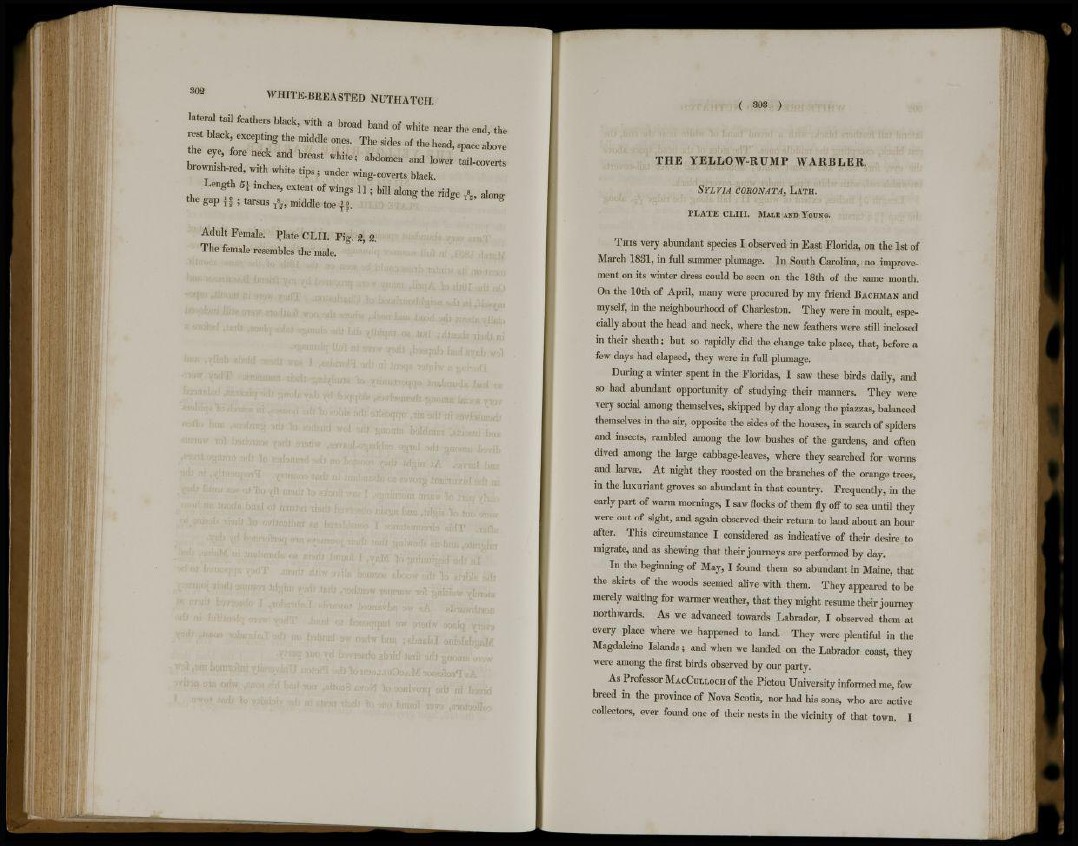
302
WHITE-BREASTED NUTHATCH.
lateral tail feathers black, with a broad band of white near the end, the
rest black, excepting the middle ones. The sides of the head, space above
the eye, fore neck and breast white; abdomen and lower tail-coverts
brownish-red, with white tips; under wing-coverts black.
Length 5 | inches, extent of wings 1 1 ; bill along the ridge ft, along
the gap \% ; tarsus ft, middle toe jg.
Adult Female. Plate CLII. Fig. 2, 2.
The female resembles the male.
T H E Y E L L O W - R U M P W A R B L E R .
SYLVIA CORONATA, LATH.
P L A T E C L I I I . MALE AND YOUNG.
THIS very abundant species I observed in East Florida, on the 1st of
March 1831, in full summer plumage. In South Carolina, no improvement
on its winter dress could be seen on the 18th of the same month.
On the 10th of April, many were procured by my friend BACHMAN and
myself, in the neighbourhood of Charleston. They were in moult, especially
about the head and neck, where the new feathers were still inclosed
in their sheath; but so rapidly did the change take place, that, before a
few days had elapsed, they were in full plumage.
During a winter spent in the Floridas, I saw these birds daily, and
so had abundant opportunity of studying their manners. They were
very social among themselves, skipped by day along the piazzas, balanced
themselves in the air, opposite the sides of the houses, in search of spiders
and insects, rambled among the low bushes of the gardens, and often
dived among the large cabbage-leaves, where they searched for worms
and larva?. At night they roosted on the branches of the orange trees,
in the luxuriant groves so abundant in that country. Frequently, in the
early part of warm mornings, I saw flocks of them fly off to sea until they
were out of sight, and again observed their return to land about an hour
after. This circumstance I considered as indicative of their desire to
migrate, and as shewing that their journeys are performed by day.
In the beginning of May, I found them so abundant in Maine, that
the skirts of the woods seemed alive with them. They appeared to be
merely waiting for warmer weather, that they might resume their journey
northwards. As we advanced towards Labrador, I observed them at
every place where we happened to land. They were plentiful in the
Magdaleine Islands; and when we landed on the Labrador coast, they
were among the first birds observed by our party.
As Professor MACCULLOCH of the Pictou University informed me, few
breed in the province of Nova Scotia, nor had his sons, who are active
collectors, ever found one of their nests in the vicinity of that town. I